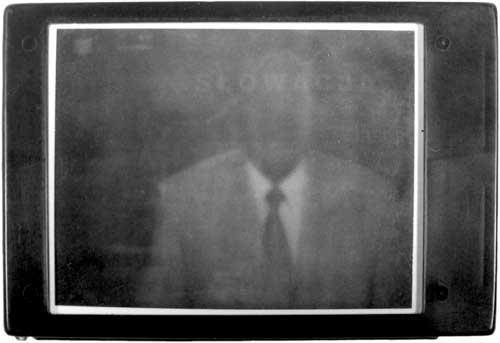Feeding the Fish
17.09 - 2.10.1999
Karmienie ryb, © Zbigniew Tomaszczuk 1999
Komedia roku, © Zbigniew Tomaszczuk 1999

All media are extensions of some human faculty
- psychic or physical.
Marshall McLuhanFeeding the Fish
Photography of Zbigniew Tomaszczuk astonishingly often relates to media, to the way media function in our culture. It is not only approach of a critic or theoretician - even the artist has sufficient knowledge and inclinations to deal with these issues. It is rather the work of an artist who is strongly aware what media are and who approaches them with a tool that is somewhat anachronic today - a plain photography. But this tool gives him comfort of being an outsider and opportunity to speak ironicaly and to deride. But these lightly presented visual treatises sometimes happen to be an illustration to some essential theses preached by serious media researchers. His performance "Memory of Image" with cutting/amputating a tree branch and insertion of an electronic "artificial limb" instead is a good illustration of McLuhan's media model - media that are extension of human faculties. Next is the series of twice exposed portraits amusingly commentating on history of photography in which models are imprisoned in a strangely built pillory. This series is an attempt to overcome time freezing character of photography, a try to push into one image some action that takes place in time. Another such an attempt - reduced to absurdity and yielding blurred image practically impossible to recognize - is a work called "Pinhole-TV". This is a kind of dough mixed from consequent TV images. I have used the word "dough" not only because the homogeneity of resulting image increases in time like a dough becomes smoother when it is mixed longer, but above all because of jokingly expressed artist's assumption - science fiction style - that someday, somewhere it will be possible to put this image into some special device which will replay everything like it was a movie. This reminds me superstitious conviction of old housewives that if they will mix dough in direction different from it was mixed from the begining then they will go back to separate ingredients again: flour, butter, sugar, eggs.
Photography of Zbigniew Tomaszczuk astonishingly often relates to media, to the way media function in our culture. It is not only approach of a critic or theoretician - even the artist has sufficient knowledge and inclinations to deal with these issues. It is rather the work of an artist who is strongly aware what media are and who approaches them with a tool that is somewhat anachronic today - a plain photography. But this tool gives him comfort of being an outsider and opportunity to speak ironicaly and to deride. But these lightly presented visual treatises sometimes happen to be an illustration to some essential theses preached by serious media researchers. His performance "Memory of Image" with cutting/amputating a tree branch and insertion of an electronic "artificial limb" instead is a good illustration of McLuhan's media model - media that are extension of human faculties. Next is the series of twice exposed portraits amusingly commentating on history of photography in which models are imprisoned in a strangely built pillory. This series is an attempt to overcome time freezing character of photography, a try to push into one image some action that takes place in time. Another such an attempt - reduced to absurdity and yielding blurred image practically impossible to recognize - is a work called "Pinhole-TV". This is a kind of dough mixed from consequent TV images. I have used the word "dough" not only because the homogeneity of resulting image increases in time like a dough becomes smoother when it is mixed longer, but above all because of jokingly expressed artist's assumption - science fiction style - that someday, somewhere it will be possible to put this image into some special device which will replay everything like it was a movie. This reminds me superstitious conviction of old housewives that if they will mix dough in direction different from it was mixed from the begining then they will go back to separate ingredients again: flour, butter, sugar, eggs. Fish" which has lent its title to this exhibition. But it seems to me that there is a common denominator for these works so differing in style. This is absurdity - one time created consciously, the other time just noticed in surrounding reality. Exactly the absurdity of situation created in "Feeding the Fish" - artist feeds with chocolate bar a wide open mouth of an dried out fish - is bluntly and univocally summing up our situation in the face of invasion of commercial advertisments: we are like silent fish fed with just anything (perhaps with this perfectly mixed dough with unknown additives) but nevertheless wrapped in glossy and rustling package. Maybe the comparison with the real television commercial of this product which used images of aromatic (certainly) hay and healthy country life and suggested that this everything, besides of indefatigable energy, is contained in each candle bar of brand X or Y will help us to realize what our situation is.
Just this critical attitude and implied etical choices emerging from the work of Zbigniew Tomaszczuk constitute, apart from individuality of style, particular value of his art.Krzysztof Wojciechowski


Z serii Dagerrotypomania, © Zbigniew Tomaszczuk 1999
z cyklu Pinhole-TV-Polaroid - Panorama, 11.07.1996, godz. 21.02 - 21.14
© Zbigniew Tomaszczuk 1999
z cyklu Pinhole-TV-Polaroid - Obrady Sejmu, 16.09.1996, godz 12.00 - 12.12
© Zbigniew Tomaszczuk 1999
Look also - FOTOTAPETA: Obszary Prywatno¶ci
Copyright ©1999 Zbigniew Tomaszczuk, Krzysztof Wojciechowski, Galeria FF £DK






